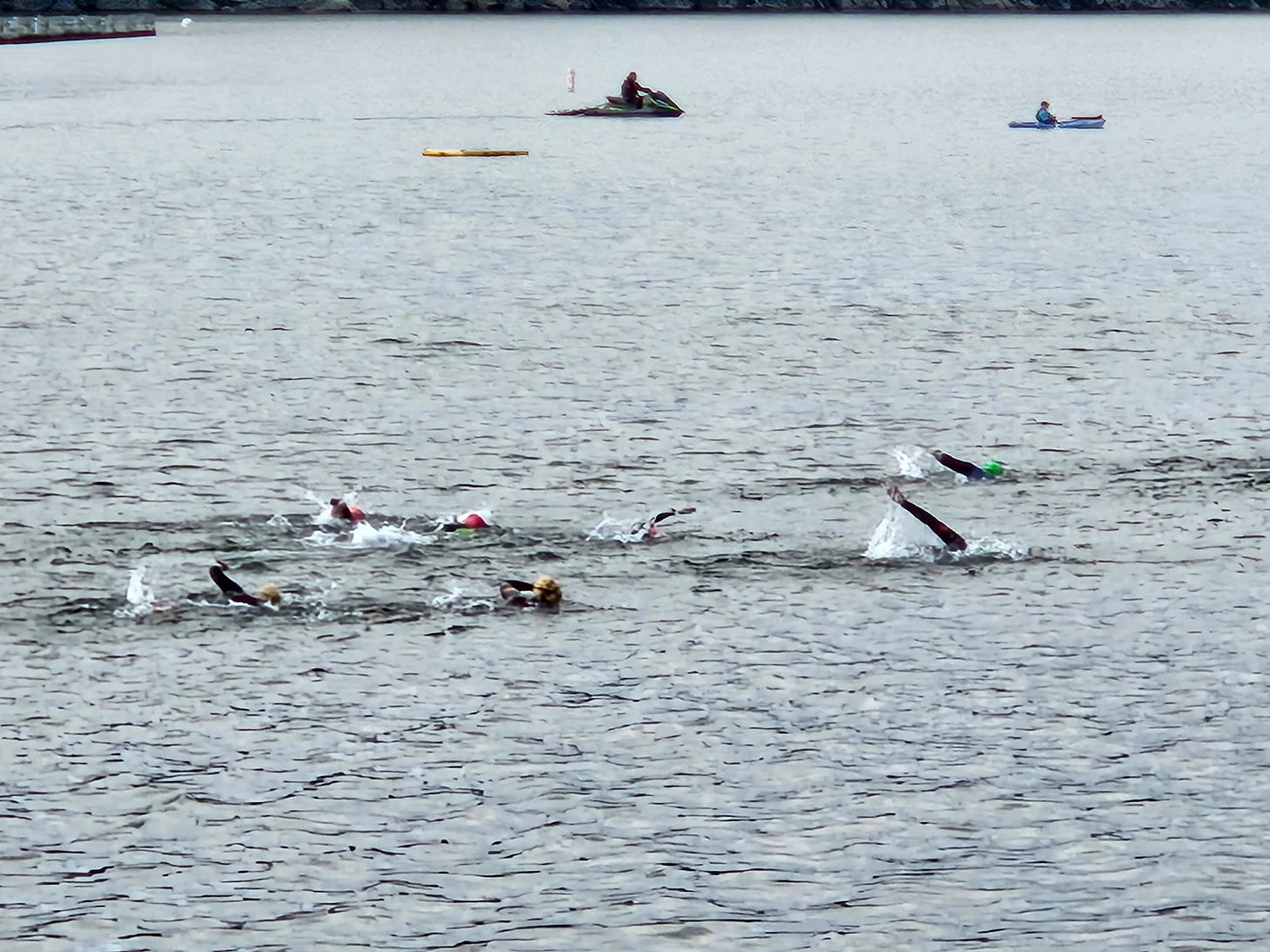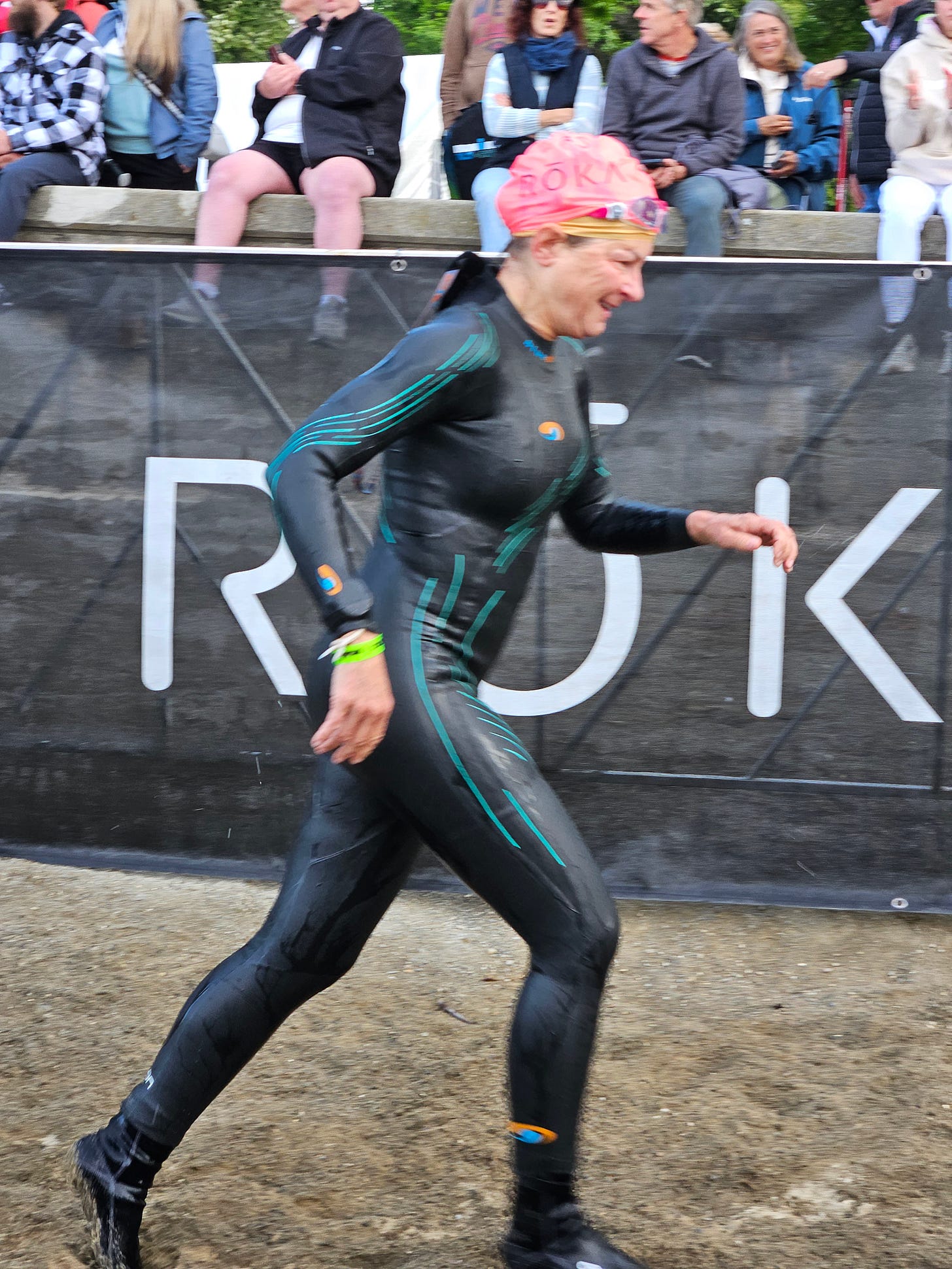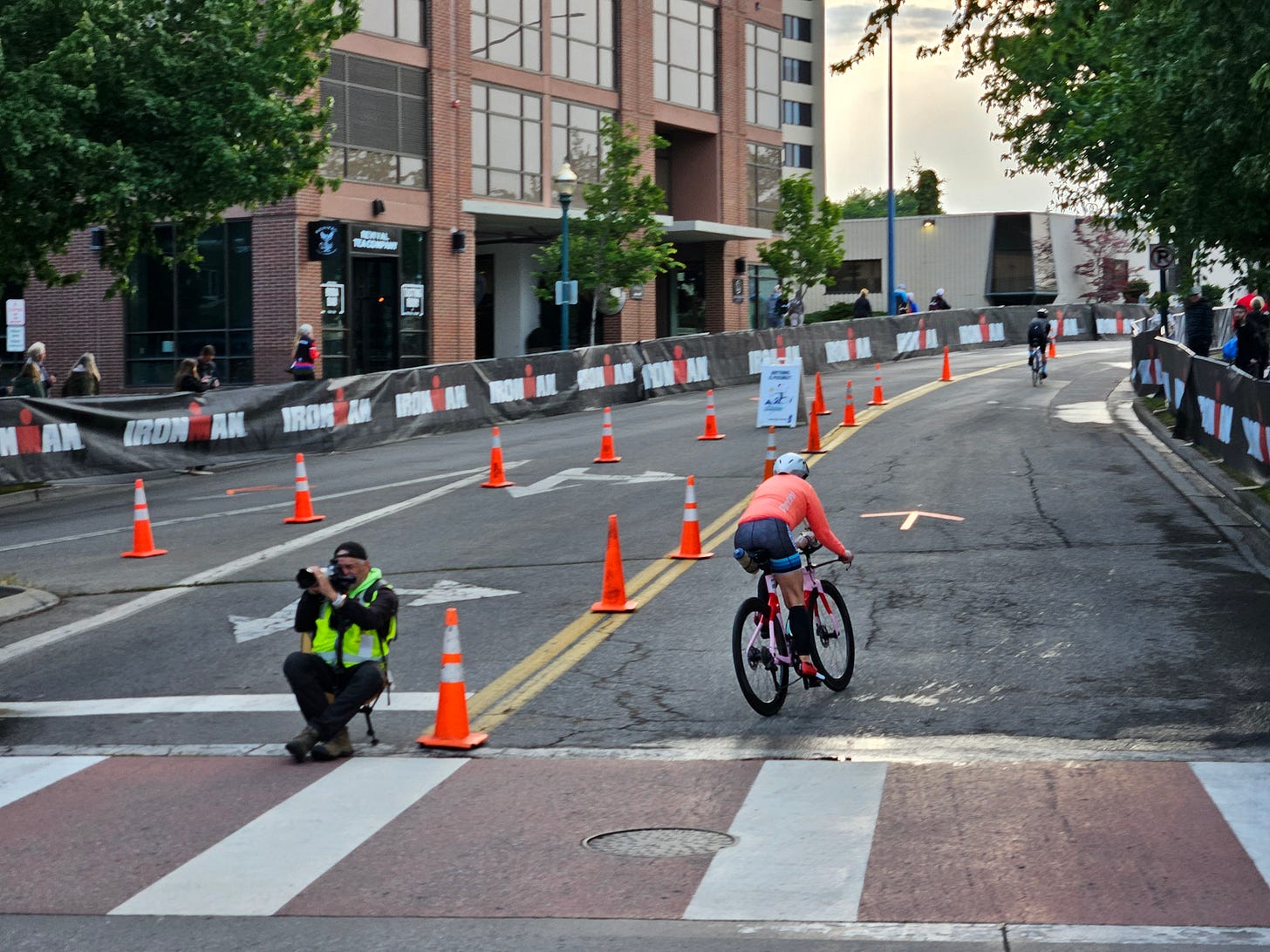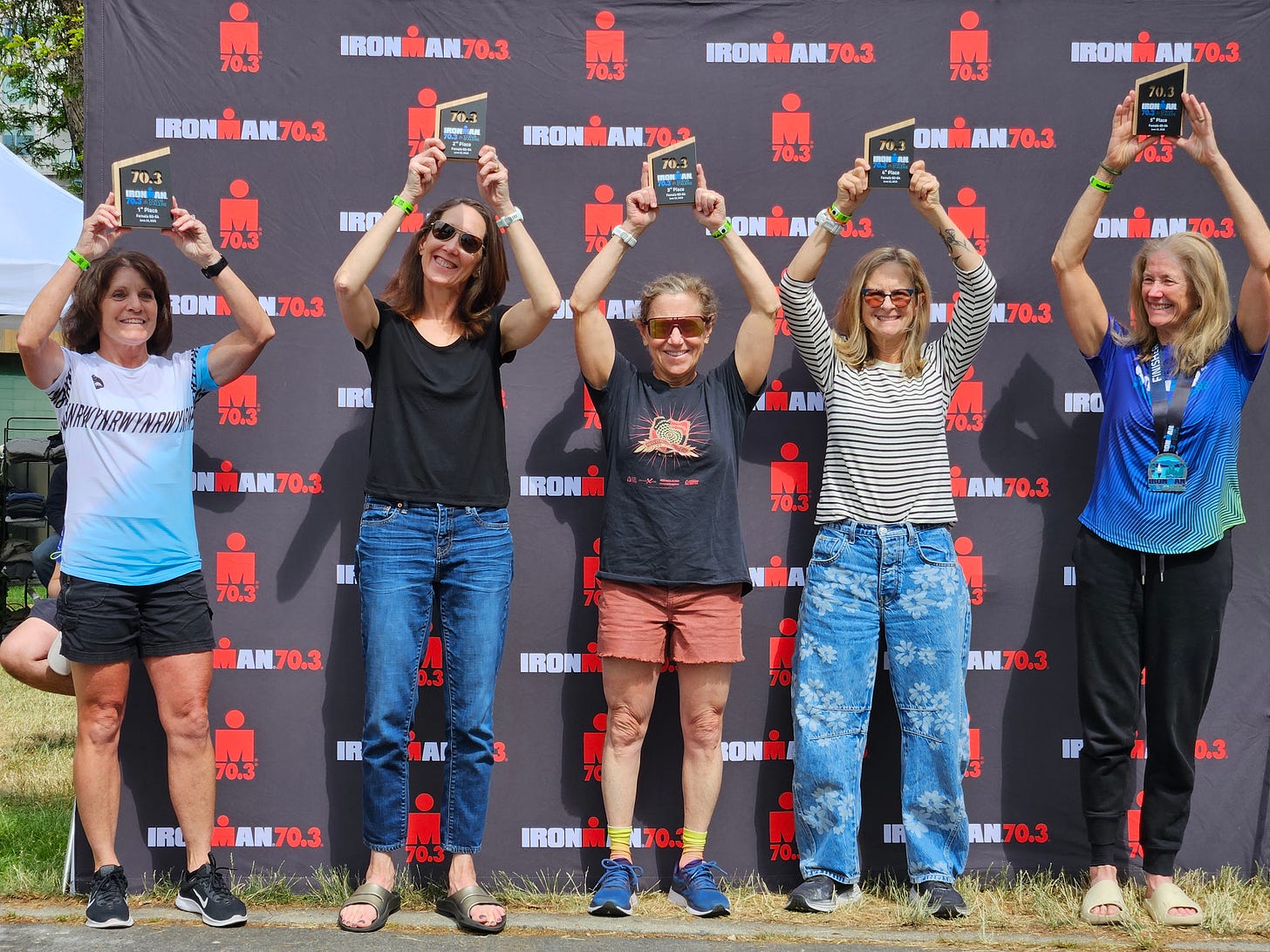Last week’s post covered the drive to and from Coeur d’Alene, Idaho, for the Ironman 70.3 triathlon in which my wife competed. Here’s the race report with, as usual, some water issues that managed to find me! You can find previous triathlon race reports here.
Friday
Uncharacteristically cold weather greets us on our arrival after our drive across Washington State.
Brenda is supposed to do a practice swim today, so we walk on over only to find that the wind has picked up, the water is choppy, and no one else is swimming, so she decides to pass. We listen to the athlete briefing and learn that athletes are asked not to swim there anyway because of sea plane activity. As we're a couple of hours too early to check in we opt to drive the first twenty miles or so of the bike course.
The AirBnB is just fine, airy and quiet. It’s in a house built in 1910 and converted into four apartments a few decades later. It’s in an area full of vacant lots and weeds, but ripe for gentrification. It's just a five-minute walk from downtown, the swanky CDA resort on the lake, and a brand-new Marriott under construction, and just ten from the race start.
We forgo a social gathering to spend a quiet evening in, practicing for an early start on race day.
Saturday
Brenda heads out for a practice ride, after which I meet her at the race check-in. As she places her bike in the transition corral, I count around a thousand bike spots, less than half the number we’ve seen at recent races. The weather is chilly and windy again and the lake again is choppy. With rain in the forecast, she puts plastic bags over the bike seat and electronics, although, as her coach points out, she’ll be wet from the swim when she gets on it tomorrow!
Brenda’s friend Annie, who costarred in this post, arrives in town to watch Brenda and some other athletes, and then it’s another quiet night before the big day tomorrow, worrying about the weather forecast.
Sunday
We’re up around dawn on race day and are pleasantly surprised that the overnight rain stopped, leaving mild weather, calm wind, and overcast skies which will minimize the sun glare for the athletes as they swim into the sunrise. We walk to the start and are happy to see the water looking like a millpond.
Swim
The time of year and latitude means the race can start at 6:00 am. Brenda’s seeded herself a little further up the order this time and this, with fewer athletes, means she’s in the water soon after the starting gun.
Lining the bed of Lake Coeur d’Alene are 75 million metric tons of toxic sediment containing lead, mercury, arsenic and other contaminants1. Knowing this, how can I let my wife swim in there? Well, the toxins are sequestered at the bottom of the lake and will stay there, as long as the oxygen level in the water remains high enough. But shoreline development with associated runoff from septic systems, lawn fertilizer, and other nutrient sources threatens to disrupt the phosphorus cycle, leading to eutrophication and oxygen depletion2. Under these circumstances those sequestered toxins can come back into solution in the water. That sediment came from the Bunker Hill Mining Complex3 up the Silver Valley, where mine tailings were dumped in the Coeur d’Alene River and are still being washed into the lake.
T1
Brenda finishes the swim in a personal best time of under 40 minutes and heads up to the first transition area, T1, to get ready for the bike stage and heads out less than five minutes later in fourth place in her age group.
Bike
The bike course takes her downtown, through a residential neighborhood, and out along the lake shore to the turnaround at Higgens Point, where, high above, I90 heads over a ridge to the Silver Valley, home of the mines that polluted the lake. And not just the lake.
In 1974, a bag house fire at the Bunker Hill smelter took out of service the filters that kept lead particles out of the air. Instead of shutting down the smelter they kept it running, causing a lead poisoning epidemic in local children. In 2024, EPA, Idaho Department of Environmental Quality, and Panhandle Health celebrated 50 years of working to protect children from lead poisoning and clean up the environmental damage.4
My wife’s family grew up in Washington within the “Tacoma Aroma” from the Asarco smelter there, which was fed with Bunker Hill lead, and in the shadow of the region’s most famous serial killer, Ted Bundy. In her book Murderland: Crime and Bloodlust in the Time of Serial Killers5, author Caroline Fraser, interviewed here on Substack by
, draws a link between the pathologies of Pacific Northwest serial killers, lead poisoning, and the mine owners who let it happen.Silver Valley is now home to the Trail of the Coeur d’Alenes, a 72-mile scenic rail trail on the track bed of the old mining railroad.6 Annie rode part of it on her way to see us and was as amazed by its beauty as she was when she learned of its history.
Unbelievably, the first Trump administration’s EPA hatched a deal to allow the mine to reopen, although the planned start this year has been delayed by cost overruns. 7
Our cyclists head back through town and out on US 95 which takes them through Mica into the Coeur d'Alene Reservation8, Palouse prairie, and almost to the WA state line, before doubling back to the transition.
T2
Brenda finishes the bike in an uncharacteristic fourth place in her age group. A number of strong athletes have aged up this year from the age group below and are giving her some competition. A transition time of under four minutes has her back out on the run, currently up to third place in her age group.
Run
The sun’s come out, but it’s still not hot, for perfect running conditions. I hang out at McCuen Park where the runners pass me twice. The run parallels the first part of the bike course along the lake, but follows the North Idaho Centennial Trail9, part of which is a rail trail on the track bed of the Coeur d’Alene to Spokane railroad, built originally, as you might guess, to carry lead ore.
Finish
After the second pass I head to the finish. Brenda managed to hold third place until the last couple of miles when a faster runner eventually reeled her in.
And so, a race wrapped up with no major drama for a change! I can’t leave Coeur d’Alene without a big thank you to the thousand volunteers - one per athlete! - that this town of around 50,000 manifested for the event.
Thank you, as always, for reading or listening. It’s summer and many of my projects are, like the grass on my lawn, dormant. I have a road trip loosely planned for August, which is sure to provide fodder for some posts, but what I’ll write about for the rest of this month may be a surprise for me as much as it is for you. I hope you stick around to find out!










Congrats to Brenda (and holy wow, people who opt to take on such challenges blow my mind)! As for the toxic Bunker Hill legacy, I'm curious: Did you know about that before the triathlon event was held there? Guessing yes, since you're so in tune and your wife is from that area. I wish Frasier's book could help start a "Silent Spring" kind of movement. Everywhere we look we find similar stories. Effing profit. Thanks for an interesting, if somewhat disheartening, read. At least there's joy in those who accomplished such incredible physical feats!
Yay Brenda! What a fierce woman. I liked how you shared knowledge through the lens of the triathlon.